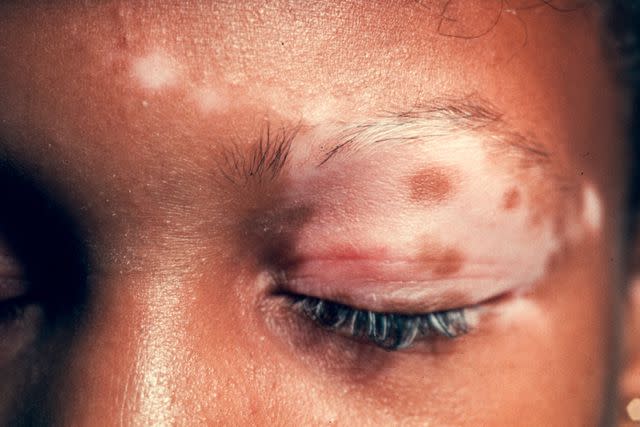What Is Vitiligo?

Vesnaandjic / Getty Images
Vitiligo is a chronic disorder, often due to genetics or a change in the immune system, that causes patches of skin to lose its pigmentation, giving these areas a milky white appearance. These discolored areas typically grow larger over time and can appear on any part of the body. Treatments can impact the appearance or slow the spread of vitiligo, however, there is no cure. This disease affects all races and sexes equally and can develop at any age, although patches typically develop in about half of people with the condition before the age of 20. Vitiligo occurs in between .5 and 1% of the global population and it is not contagious or life-threatening.
The first appearance of a description of a disease that is believed to be vitiligo appears in the Hebrew version of the book of Leviticus from the Old Testament, which is dated to around 1280 B.C. However, a subsequent Greek translation of the text changed the word to leprosy as the diseases were often grouped together at the time. Vitiligo also appears in an ancient Egyptian medical text called the Ebers Papyrus from around 1550 B.C.
Vitiligo is a chronic disease that causes patches of depigmented skin to appear on the body, often due to genetics or a change in the immune system.
Vitiligo Symptoms
The only symptom of vitiligo is the appearance of patches of depigmented skin, called macules. These appear most often on the extremities, although they can occur anywhere. Macules are small to begin with, but typically will grow and change shape over time. The edges of the patch can appear smooth or irregular. Some people experience itching before a new patch appears. If you have vitiligo on a part of the body that has hair on it, the hair may turn white or silver as well.
Types of Vitiligo
Non-Segmental Vitiligo
Non-segmental vitiligo is the most common type of vitiligo, affecting about 9 in 10 people with the condition. With non-segmental vitiligo, there is usually a symmetry in the location of the depigmented patches. New patches appear over time and can either cover large portions of the body or be contained to particular areas. People can develop non-segmental vitiligo at any age.
There are different classes of non-segmental vitiligo:
Generalized vitiligo - This is the most common pattern. Areas of depigmentation are randomly distributed across the body.
Universal vitiligo - The depigmentation covers the majority of the body, leaving very little pigmented skin.
Focal vitiligo - The depigmentation is concentrated to one or a few scattered patches in one area. This is most commonly found in children.
Acrofacial vitiligo - Only the fingers and periorificial areas are affected
Mucosal vitiligo - Only the mucous membranes are affected.
Trichome vitiligo - This form manifests as a bullseye with a white or colorless center, then an area of lighter pigmentation, then an area of natural skin tone.
Segmental Vitiligo
Segmental Vitiligo differs in appearance, cause, and frequency to non-segmental vitiligo and only affects one side of the body or one area. It tends to affect the areas of skin associated with the spinal cord’s dorsal roots and is much more stable than non-segmental vitiligo, with a weaker association to autoimmune diseases. It also does not improve with topical creams or UV light therapies. This variation is more common in children, affecting around 3 out of 10 kids with vitiligo. It is thought to be triggered by chemicals released from the nerve endings in the skin that are poisonous to the melanocyte skin cells.
Causes of Vitiligo
The cause of vitiligo is unknown, but studies strongly suggest that it’s related to changes in the immune system. However, it is considered to be a multifactorial disease with genetic and environmental factors also playing a significant role. These pigmentless patches begin appearing when the melanocytes – the cells that make the skin’s pigment, or melanin – are attacked and destroyed by the body’s immune system, causing the skin to turn a milky white color.
Vitiligo is also sometimes associated with autoimmune and inflammatory diseases, such as Hashimoto's thyroiditis, scleroderma, rheumatoid arthritis, type 1 diabetes mellitus, psoriasis, Addison's disease, pernicious anemia, alopecia areata, systemic lupus erythematosus, and celiac disease.
Vitiligo can also be caused by environmental elements, such as ultraviolet radiation or exposure to toxic chemicals that alter the function of melanocytes. And studies indicate that about 30% of vitiligo cases are genetic.

Westend61/Getty Images
Complications from Vitiligo
Sensitive Skin
Due to the lack of melanocytes in the skin, these depigmented patches can become more sensitive to sunlight exposure which can lead to sunburns or even skin cancer.
Eye Abnormalities
Some people with vitiligo will experience abnormalities with their retinas and some variation in the color of their irises. In some cases, these abnormalities will be accompanied by inflammation, but vision is usually not impacted.
Hearing Loss
Those diagnosed with vitiligo can experience partial hearing loss due to the loss of cochlear melanocytes.
Predisposition to Autoimmune Conditions
Those with vitiligo can also be more likely to get an autoimmune condition, such as hypothyroidism, diabetes, and anemia.
Mental Health Struggles
People with vitiligo can become embarrassed or self-conscious over their appearance, leading to anxiety and depression which can become exasperated as they continue to socially isolate themselves due to the disease.
Diagnosis
A visual examination by a doctor is typically enough for an accurate diagnosis of vitiligo. However, ultraviolet light can also be used to identify the disease in its early phases. Under the blacklight, the skin will change color when affected by certain bacteria, fungi, and changes in skin pigmentation.
While there is no cure for vitiligo, there are treatments that can be effective at stopping the progression of the disease, including topical medications, light therapy, and surgery.

Reproduced with permission from © DermNet New Zealand and © Dr. Lawrence Meyerson www.dermnetnz.org 2023.
Treatment
Applying topical steroids has proven to be moderately beneficial and is typically the primary recommended form of treatment. Immune suppressing medications such as glucocorticoids and calcineurin inhibitors are most often prescribed, and in July 2022 the cream ruxolitinib was approved in the United States for the treatment of vitiligo. It is the first FDA-approved pharmacologic treatment to address repigmentation in vitiligo patients.
Phototherapy is the second most-recommended treatment involving exposing the affected skin to UVB lamps or medical-grade lasers. Sessions are done two to three times a week and can take anywhere from a few weeks to a few months to show signs of improvement. Phototherapy comes with the potentially deadly side effect of developing skin cancer due to the increased exposure to UVB light.
Epidermal grafting has also become a popular procedure to reduce the appearance of macules, especially amongst those who have proven resistant to non-surgical treatments. Using this procedure, the damaged melanocytes causing the vitiligo are replaced using either tissue grafting or cellular grafting techniques. The first type of graft involves transferring the skin tissue as a whole to the depigmented area, while the second requires further breaking down the skin graft into its cellular components and then applying that to the affected spot.
In mild cases, vitiligo can be covered with makeup and other full-coverage cosmetics.
Vitiligo is typically permanent; however, around 10 to 20% of people with vitiligo fully regain their skin pigmentation. This occurs most often amongst those who receive a diagnosis before the age of 20, have symptoms primarily in the area of their face, and who experience the peak of the condition spreading within six months or less. This is less likely to occur in those over the age of 20 or with macules on their lips, limbs, or hands.
For more People news, make sure to sign up for our newsletter!
Read the original article on People.


